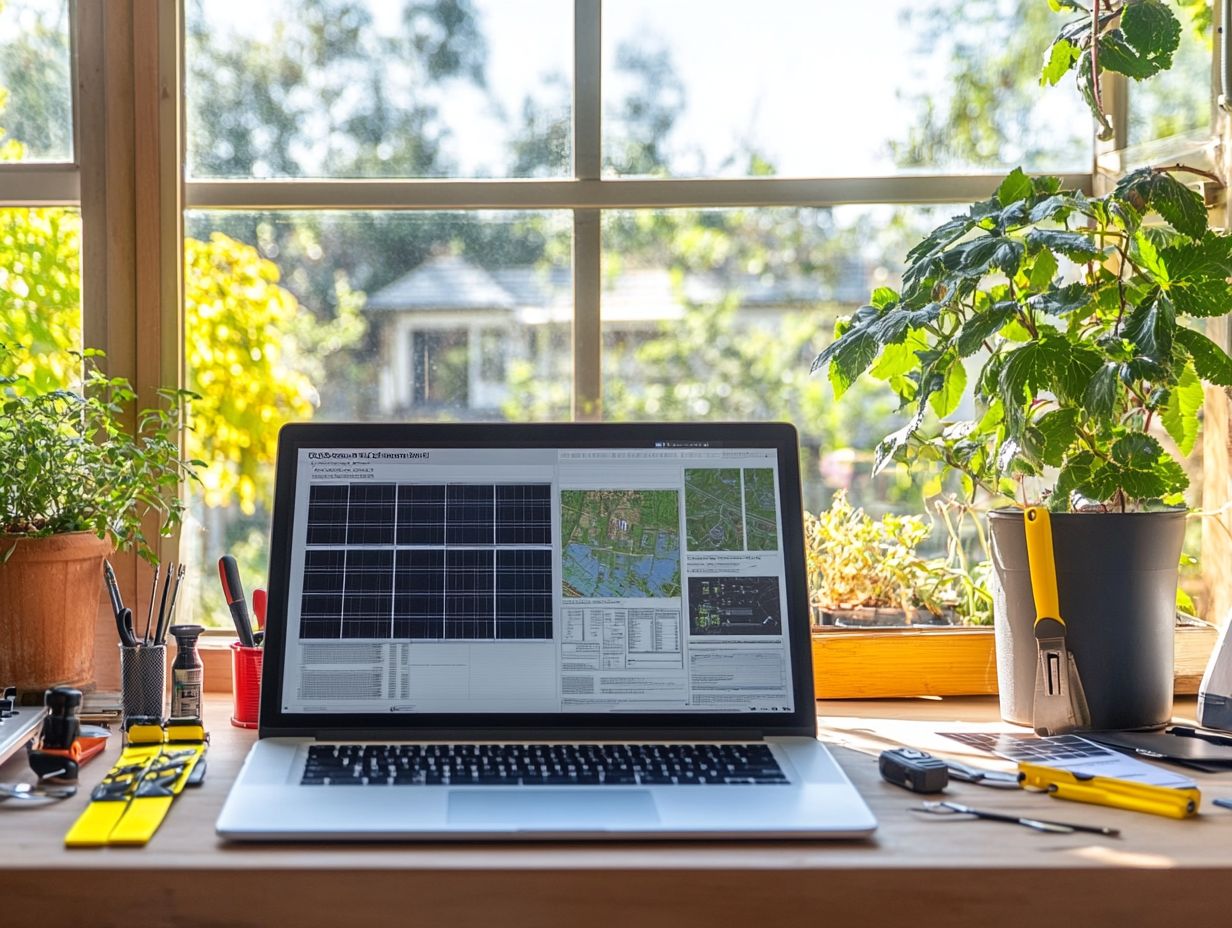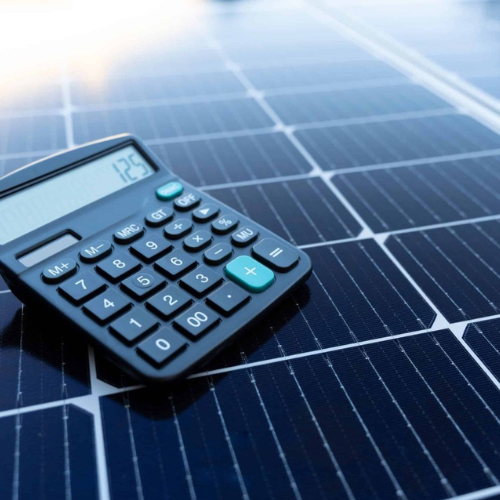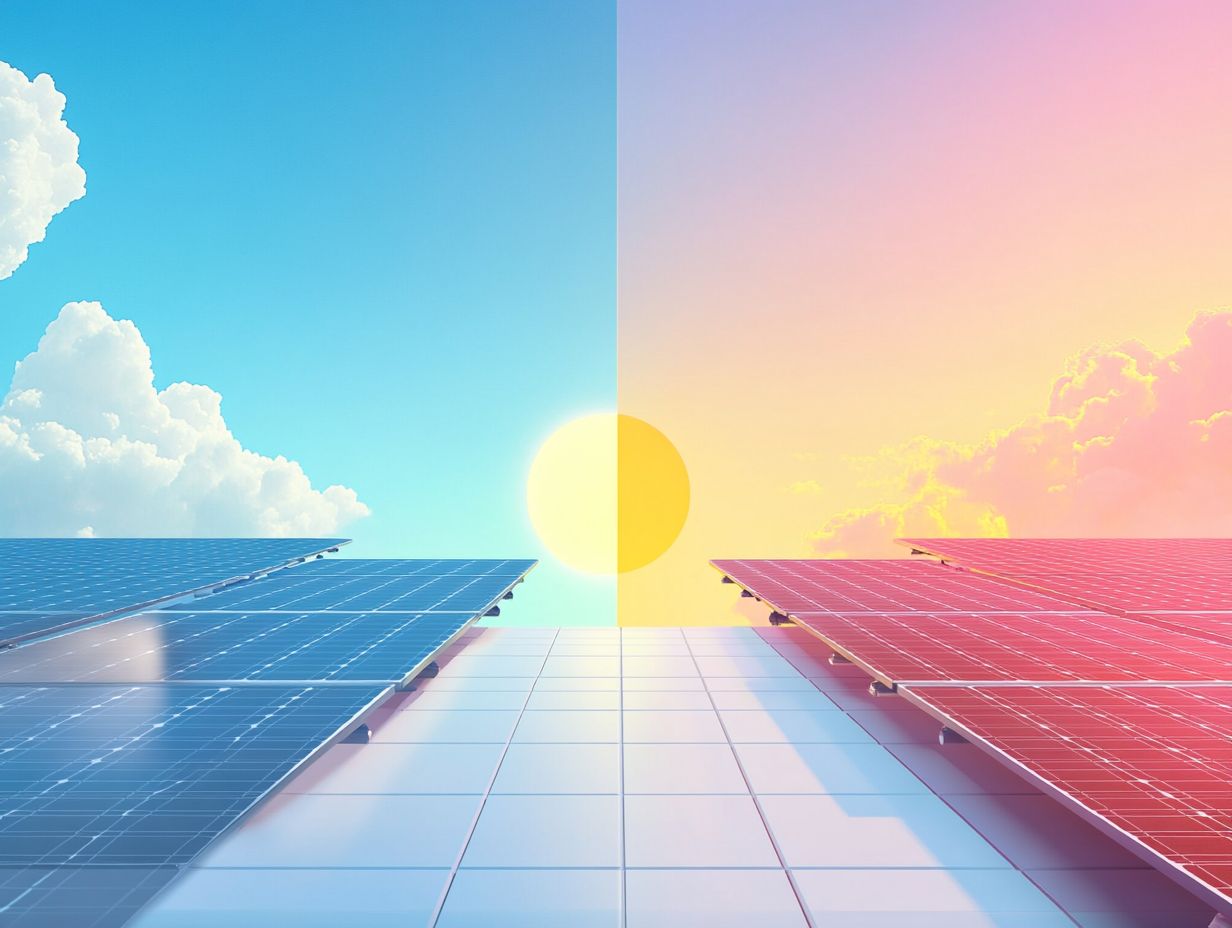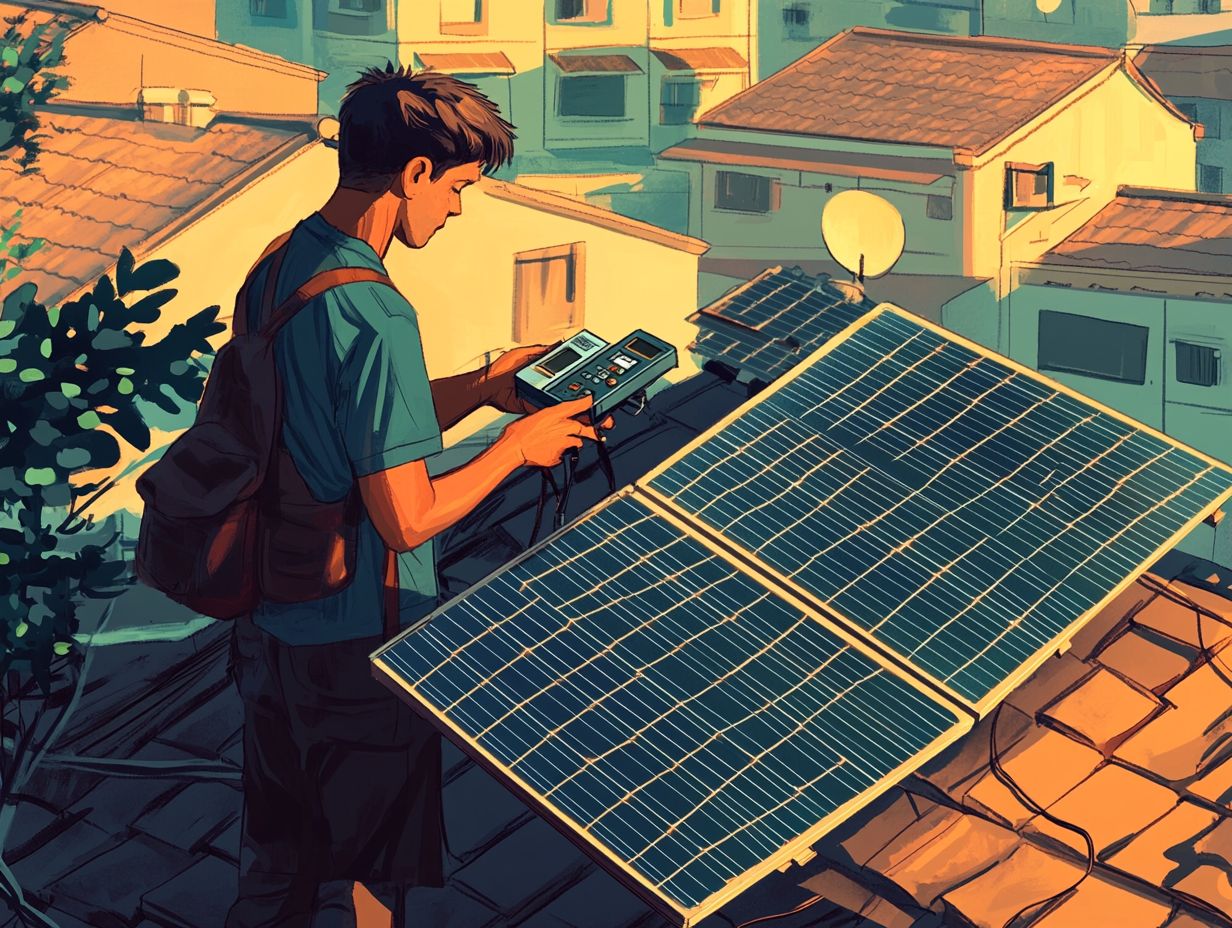Contents
- 1 Key Benefits of Installing Solar Panels
- 2 Factors to Consider Before Solar Panel Installation
- 3 Understanding Different Types of Solar Panel Systems
- 4 Steps for Installing Solar Panels
- 5 Solar Panel Maintenance and Upkeep of Solar Panels
- 6 Frequently Asked Questions
- 6.1 What is the first step to take in solar panel installation?
- 6.2 What Types of Roofs are Suitable for Solar Panel Installation?
- 6.3 How long does it take to install solar panels?
- 6.4 Do I need to upgrade my electrical system for solar panel installation?
- 6.5 Will I still receive an electricity bill after installing solar panels?
- 6.6 Is there a warranty for solar panel systems?
Understanding Solar Panel Installation

When you think about solar panel installation, it’s all about setting up those solar energy systems that capture the sun’s rays to generate electricity using photovoltaic technology. This involves understanding solar panel types, installation timeline, and potential downtime. This means you’ve got options for both residential installations for your home and commercial setups for businesses, each designed to fit specific energy needs.
The whole installation process includes several steps, from assessing your site and getting permits to making that final grid connection, all to make sure everything runs efficiently and meets local regulations.
By jumping on the solar energy bandwagon, you can significantly cut down your dependence on fossil fuels and help create a more sustainable future. Those photovoltaic systems work their magic by converting sunlight directly into electricity, making them a clean energy source that helps reduce greenhouse gas emissions.
Plus, you could rack up some substantial savings on your energy bills over time, especially with solar incentives like tax credits and federal rebates, giving you a nice financial boost along with those environmental perks.
Thanks to advancements in solar technology, both residential and commercial solar options are getting more scalable, giving you the flexibility to meet a wide range of energy demands while promoting energy independence.
Key Benefits of Installing Solar Panels
Installing solar panels comes with a variety of benefits, making it a savvy choice for homeowners and businesses that care about the environment.
By tapping into solar energy, you can really cut down on your utility bills, snag some tax credits, and do your part for the planet by reducing your carbon footprint.
Plus, those solar panels can boost your property value and offer long-term energy independence, letting you shine as a sustainable leader in your community.
Environmental and Financial Benefits of Solar Panels
One of the best perks of installing solar panels is that you get to experience both environmental sustainability and financial savings. By generating clean solar energy, you’re doing your part to reduce greenhouse gas emissions while also slashing your energy costs. This smart use of renewable energy not only helps fight climate change but can also lead to some significant savings on your utility bills over time.
Solar energy systems help you depend less on fossil fuels, creating a more sustainable energy framework that benefits both you and the planet. For example, many homeowners have found that their monthly utility expenses drop by as much as 50% to 75% after making the switch to solar.
Plus, with government incentives like tax credits and rebates, you can boost those savings even more, making solar investments not just good for the environment but also a savvy financial move.
These incentives can help offset those initial installation costs, encouraging more households to embrace renewable energy solutions. The overall impact of these financial benefits shows a growing trend toward sustainable living, where economic viability meets ecological responsibility, supported by solar financing and government programs.
Fthenakis, V., & Kim, H. C. (2007). Greenhouse gas emissions from solar electric- and nuclear power: A life-cycle study. Energy Policy, 35(4), 2549-2557. Link
Factors to Consider Before Solar Panel Installation
Before you dive into solar panel installation, there are some key factors to think about that can impact both your system’s efficiency and your adherence to local regulations.
It’s essential to carry out a thorough site assessment, get a clear picture of your energy needs, and be aware of the installation costs and any permits you might need. All of these elements can greatly affect the overall success of your solar energy project.
Each one plays a vital role in designing a system that fits your specific requirements while maximizing your benefits, including energy efficiency and energy output.
Assessing Your Home’s Energy Needs for Solar Installation

Assessing your home and energy needs is a crucial step to make sure your solar panel installation fits your unique energy requirements. By conducting an energy audit, you can get a clear picture of your current energy consumption, kilowatt-hour usage, and spot areas where you could boost energy efficiency.
This thorough assessment will help you figure out the right size for your solar system, which can lead to lower utility bills and a better return on your investment in renewable energy and increased home value.
To kick things off, gather data on your energy usage from the past year, including your electricity bills and the energy ratings of your appliances. It’s important to recognize when your peak usage times are and how your energy consumption changes with the seasons.
Once you have all this information, calculate your overall energy needs and think about potential upgrades, like energy-efficient appliances or better insulation. This detailed analysis will not only clarify how much solar power you’ll need but will also highlight opportunities for reducing your energy footprint.
In the end, taking this well-informed approach will provide you with long-term financial benefits and support your sustainable living goals, all while ensuring your solar installation is effective and suits your household’s energy habits. This approach aligns with environmental sustainability goals.
Understanding Different Types of Solar Panel Systems
When you’re thinking about installing solar panels, it’s important to understand the different types of solar panel systems out there, like grid-tied, off-grid, and hybrid systems, and their respective suitability for rooftop installation or ground-mounted systems.
Each type comes with its own set of advantages that cater to your specific energy needs and preferences.
- Grid-tied systems connect to the utility grid, giving you perks like net metering.
- If you’re after complete energy independence, off-grid systems are an excellent choice.
- And if you want the best of both worlds, hybrid systems blend features from each, providing flexible energy solutions that adapt to your lifestyle.
Understanding Grid-Tied, Off-Grid, and Hybrid Solar Systems
Understanding the differences between grid-tied, off-grid, and hybrid solar systems is key to picking the right setup for your energy needs. Each type comes with its own unique features and benefits that cater to different lifestyles and preferences.
If you’re looking to cut down on your utility bills while still having access to conventional power when you need it, a grid-tied system with net metering might be the way to go. On the flip side, if you live in a more remote area and want complete energy independence, an off-grid system lets you harness renewable sources for a self-sustaining electric supply.
Then there are hybrid systems, which are pretty cool because they integrate solar batteries for storage solutions. This means you can store extra solar power for those times when the sun isn’t shining—like during outages or at night. Plus, if you have a grid connection with effective net metering, you can really rack up the savings by selling any excess energy back to the grid, enhancing your overall energy management and energy goals.
It creates an efficient and cost-effective energy ecosystem just for you.
Steps for Installing Solar Panels
Installing solar panels involves a few key steps that will make sure everything goes off without a hitch.
- First up, you’ll want to conduct a site assessment to see how well your location is suited for solar energy.
- Then, it’s time to select a qualified contractor who knows their stuff.
- Don’t forget about the necessary permits – getting those sorted is a crucial step.
- You’ll also need to prepare the site for installation.
- Having a well-structured installation timeline will help you manage expectations and keep everything on track, so you end up with a solar system that meets your energy needs efficiently and proceed smoothly and efficiently.
Planning and Preparing for Solar Panel Installation

Effective pre-installation planning and preparation are key to a successful solar panel installation, helping you ensure that every detail is considered. You’ll want to start with a thorough site assessment to check out sunlight exposure and shading, and don’t forget to gather the necessary permits required by local regulations.
Choosing a qualified contractor who understands safety measures and local building codes is crucial too, as it can save you from potential headaches down the line and ensure adherence to environmental regulations. Proper planning not only streamlines the installation process but also enhances the overall efficiency and longevity of your solar energy system.
This careful planning isn’t just about the technical stuff; it creates the perfect environment for a smooth installation process. You’ll need to assess the structural integrity of your roof and figure out the best placement for optimal energy production—these details are important to get right.
Understanding safety protocols and electrical connections is also essential to keep both the workers and your property safe during the installation. By putting in the time and effort for solid pre-installation planning, you can ensure your solar energy system works efficiently, meets all legal requirements, and contributes to sustainable energy practices.
Installation Process and Timeline
The installation process has several phases that work together to make sure your solar system is set up correctly and efficiently. After you finish the pre-installation planning, the actual installation timeline kicks in, which includes mounting the solar panels, doing the necessary electrical work, connecting everything to the grid, and ensuring compliance with local regulations.
Once it’s all installed, performance monitoring becomes crucial for tracking energy production and ensuring that your solar energy system runs optimally throughout its lifespan, maximizing energy efficiency.
Each phase plays a vital role in the overall success of the installation process, starting with careful planning that involves site assessments and obtaining the necessary permits. Regarding the mounting phase, you need to get everything aligned just right to maximize sunlight exposure and minimize shading.
Then, the electrical work is all about making sure that energy management is safe and effective, with proper electrical connections. After connecting to the grid, you’ll want to actively monitor your photovoltaic system using specialized software or apps that track performance metrics, like energy output versus consumption.
This ongoing evaluation helps you make timely adjustments or necessary maintenance, ultimately leading to energy savings, a longer-lasting system, and a smaller carbon footprint.
Solar Panel Maintenance and Upkeep of Solar Panels
Keeping up with the maintenance and care of your solar panels is crucial for making sure they work efficiently and effectively over the long haul, ensuring energy independence and benefiting from solar panel warranties.
Regular cleaning, monitoring their performance, and sticking to a maintenance schedule, including solar maintenance tips, can really stretch the lifespan of your solar panel system.
By proactively tackling any issues and following some handy solar maintenance tips, you’ll be able to enjoy all the perks of lower utility bills, increased home value, and a smaller carbon footprint.
Tips for Keeping Your Solar Panel System Efficient
In addition to maintenance, to keep your solar panel system running smoothly, it’s super important to adopt some regular maintenance tips and performance monitoring practices. Simple steps like cleaning the panels, checking for any shading, and doing periodic inspections, which are essential parts of an installation checklist, can save you from performance drops and those dreaded costly repairs.
Establishing a maintenance schedule allows you to effectively manage what needs to be done, allowing you to troubleshoot any issues before they turn into bigger problems, keeping your system eco-friendly and contributing to clean energy.
Monitoring your energy output is key, and you can easily do this through your inverter’s display or a handy app, which is part of good energy management. Make sure to jot down any irregularities in performance, as they might signal underlying issues.
Don’t underestimate the value of an annual professional inspection, which is often covered by installation companies; it’s great for checking the wiring and connections that might need some TLC over time. Watch the weather, too—debris and dust can pile up and significantly impact efficiency, so tackling that promptly is a must.
By being proactive with these practices, you can maximize your energy production and extend the lifespan of your solar panel system, which ultimately means more savings on your energy bills and greater reliance on renewable energy sources.
Skoplaki, E., & Palyvos, J. A. (2009). On the temperature dependence of photovoltaic module electrical performance: A review of efficiency/power correlations. Solar Energy, 83(5), 614-624. Link
Frequently Asked Questions

What is the first step to take in solar panel installation?
Consider exploring various solar energy solutions to benefit from renewable energy and reduce your carbon footprint.
The first step in solar panel installation is to conduct a site analysis, which includes a shading analysis. This involves assessing the location of your home or building, the amount of sunlight the area receives, and the orientation of your roof to determine the best placement for the solar panels to maximize their benefits.
What Types of Roofs are Suitable for Solar Panel Installation?
Most types of roofs, including shingle, metal, and tile roofs, are suitable for solar panel installation. However, flat roofs or those with heavy shade may require additional support or specialized installation techniques, especially for ground-mounted systems or certain solar panel designs.
How long does it take to install solar panels?
The installation process typically takes 1-3 days, depending on the size of the solar panel system and the complexity of the installation. Factors such as the weather and the condition of the roof can also affect the timeline, impacting the overall installation costs and timeline.
Do I need to upgrade my electrical system for solar panel installation?
In most cases, no upgrades are necessary. However, if your current electrical system is outdated or not up to code, it may need to be upgraded to safely accommodate the solar panel system and meet safety precautions.
Will I still receive an electricity bill after installing solar panels?
It is possible to still receive a small electricity bill after solar panel installation, as the system may not provide 100% of your energy needs. However, with net metering, your bill can be significantly reduced and potentially eliminated if your system produces more energy than you consume, especially with solar batteries.
Is there a warranty for solar panel systems?
Yes, most solar panel systems come with a manufacturer’s warranty ranging from 10-25 years. In addition, many installation companies offer a workmanship warranty to cover any potential issues with the installation process, including federal rebates and solar incentives, providing additional peace of mind.







